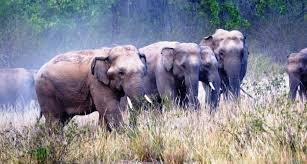When we think of India’s national parks, we think of untouched, pristine areas teeming with wildlife. The reality however can be far from it, especially in Central India. People dwell extremely close to wildlife habitats, sometimes within protected areas, raising the hottest conservation topic of today’s day and age: human-animal conflict.
Human-animal conflict is a complex and growing issue. Human populations expand into previously wild areas, resulting in frequent interactions with wildlife. These interactions often result in severe consequences for both people as well as animals, affecting livelihoods, local ecosystems, and conservation efforts.
Elephants and Humans at the Crossroads?
Elephants are extremely intelligent and sentient beings, much more than conservationists could once comprehend. Habitat loss, fragmentation, and encroachment on natural elephant corridors force these animals to search for resources near human settlements. In places where human populations live close to elephant habitats, the animals often stray into farms and villages, searching for food. As a result, crops are frequently damaged and houses demolished. This leads to significant economic losses for the farmers and sometimes even loss of life for the animals- much like what we saw in the recent incident where an entire herd of elephants was found dead in Bandhavgarh National Park.
And just like any other conflict, the damages are inflicted to both sides in equal measures. Looking to deter the herds of elephants, humans have resorted to high-voltage electric fencing, the use of explosives, poisoning, and other, often lethal methods. The rise in the number of elephant deaths owing to conflict with humans is staggering. And though the cause of death of Bandhavgarh’s elephant herd remains unidentified, most experts are certain that it’s a direct result of human-wildlife conflict.
What is being done to stop this?
NGOs and the government have been working tirelessly to mitigate such conflicts. The forest department regularly hosts awareness sessions in elephant-prone areas to sensitize the villagers on the importance of elephants and measures to avoid conflicts.
States such as Tamil Nadu and Kerala, which are home to large populations of elephants, have successfully implemented an early warning system that informs the villagers of approaching herds and helps them safeguard their lives and property. Compensation schemes in cases of loss of crops and property have resulted in reduced retaliation from the villagers.
Relocating villages from protected areas is essential for crafting a sustainable solution to the enduring challenge of human-wildlife conflict. It’s not just about safeguarding wildlife; it’s about reclaiming a balance between humans and nature. This proactive approach allows communities to thrive without the looming threat of wildlife encounters, making for a safer and more harmonious coexistence. By taking decisive action, we can pave the way for a future where both humans and animals can flourish, ensuring that our rich biodiversity is preserved for generations to come.
The Road ahead
Elephants are keystone species that play a crucial role in maintaining biodiversity and healthy ecosystems. By safeguarding elephant habitats, respecting their migratory needs, and supporting local communities, we can create a balanced approach to mitigate human-elephant conflict. Solutions that prioritize both conservation and community welfare help prevent losses on both sides, ensuring a sustainable coexistence.
Through thoughtful actions and community involvement, we can build a future where humans and elephants thrive side by side. Preserving these majestic creatures is essential—not only for biodiversity but also for the cultural and ecological health of the regions they inhabit. Sustainable, community-supported solutions will pave the way for peaceful human-elephant coexistence, preserving one of nature’s most iconic species for future generations.





